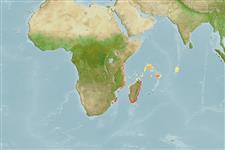Classification / Names
Nombres comunes | Sinónimos | Catalog of Fishes(Género, Especie) | ITIS | CoL | WoRMS | Cloffa
>
Acanthuriformes (Surgeonfishes) >
Antigoniidae (Deepbody boarfishes)
Etymology: Antigonia: Daughter of Oedipus and Jocasta, who defied her uncle, king Creon, by performing funeral rites over her brother Polynices and was condemned to be immured in a cave (Ref. 45335); hulleyi: Named for A.P. Hulley, South African Museum, Cape Town..
Environment: milieu / climate zone / depth range / distribution range
Ecología
marino demersal; rango de profundidad 183 - 194 m (Ref. 57877). Deep-water
Distribución
Países | Áreas FAO | Ecosistemas | Ocurrencias, apariciones | Point map | Introducciones | Faunafri
Western Indian Ocean: off Mozambique.
Tamaño / Peso / Age
Maturity: Lm ? range ? - ? cm
Max length : 7.9 cm SL macho / no sexado; (Ref. 57877)
Life cycle and mating behavior
Madurez | Reproducción | Puesta | Huevos | Fecundidad | Larva
Parin, N.V. and O.D. Borodulina, 2005. Antigonia (Caproidae) from the western Indian Ocean: 1. Species with nine spiny rays in the dorsal fin. J. Ichthyol. 45(6):417-428. (Ref. 57877)
IUCN Red List Status (Ref. 130435)
Threat to humans
Harmless
Human uses
Más información
PaísesÁreas FAOEcosistemasOcurrencias, aparicionesIntroduccionesStocksEcologíaDietacomponentes alimenticiosconsumo de alimentoRación
Nombres comunesSinónimosMetabolismoDespredadoresEcotoxicologíaReproducciónMadurezPuestaAgregación para la puestaFecundidadHuevosEgg development
Age/Size
Crecimiento
Length-weight
Length-length
Length-frequencies
Morfometría
Morfología
Larva
Dinámica larvaria
Reclutamiento
Abundancia
BRUVS
ReferenciasAcuiculturaPerfil de acuiculturaRazasGenéticaElectrophoresesheritabilidadEnfermedadesProcesamientoNutrientsMass conversion
ColaboradoresImágenesStamps, Coins Misc.SonidosCiguateraVelocidadTipo de nataciónSuperficie branquialOtolitosCerebrosVisión
Herramientas
Special reports
Download XML
Fuentes de Internet
Estimates based on models
Preferred temperature (Ref.
123201): 9.5 - 21.1, mean 15.1 °C (based on 62 cells).
Phylogenetic diversity index (Ref.
82804): PD
50 = 0.5000 [Uniqueness, from 0.5 = low to 2.0 = high].
Bayesian length-weight: a=0.02344 (0.01128 - 0.04870), b=2.97 (2.78 - 3.16), in cm total length, based on LWR estimates for this (Sub)family-body shape (Ref.
93245).
Nivel trófico (Ref.
69278): 2.9 ±0.3 se; based on size and trophs of closest relatives
Fishing Vulnerability (Ref.
59153): Low vulnerability (10 of 100).
